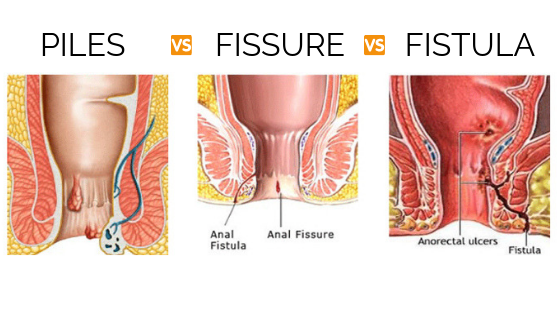Hemorrhoidal diseases are common anorectal conditions, often confused with each other due to similar symptoms. However, there are key differences between piles (hemorrhoids), fissures, and fistulas. Understanding these distinctions is crucial for timely diagnosis and effective treatment.
What Are Piles (Hemorrhoids)?
Piles, also known as hemorrhoids, are swollen blood vessels in the rectum or anus. They can be internal or external.
Symptoms:
- Rectal bleeding, especially after passing stool
- Itching or irritation in the anal area
- Pain or discomfort while sitting
- Swelling or lumps near the anus
Causes:
- Chronic constipation or straining during bowel movements
- Obesity and sedentary lifestyle
- Pregnancy
- Low-fiber diet
Treatment Options:
- Lifestyle changes such as a high-fiber diet and adequate hydration
- Over-the-counter creams and ointments
- Minimally invasive procedures like rubber band ligation or sclerotherapy
- Surgical interventions for severe cases
Also read – Can Piles be cured in 3 days?
What Is an Anal Fissure?
An anal fissure is a small tear in the lining of the anus, often caused by trauma or strain.
Symptoms:
- Sharp pain during and after bowel movements
- Bright red blood on toilet paper or in stool
- Itching or burning sensation near the anus
- Visible crack or tear in the anal skin
Causes:
- Passing hard stools due to constipation
- Chronic diarrhea
- Childbirth
- Conditions like Crohn’s disease
Treatment Options:
- Increasing fiber and water intake to soften stool
- Applying topical anesthetic creams for pain relief
- Using stool softeners to prevent further damage
- Surgery in cases of chronic fissures
What Is an Anal Fistula?
An anal fistula is an abnormal tunnel between the inside of the anus and the skin surrounding it. This condition often results from an untreated abscess.
Symptoms:
- Persistent pain and swelling near the anus
- Pus or bloody discharge from an opening near the anus
- Fever and chills (in case of an infection)
- Skin irritation and discomfort
Causes:
- Untreated anal abscess
- Crohn’s disease or other inflammatory bowel conditions
- Tuberculosis and other infections
Treatment Options:
- Antibiotics to control infection
- Drainage of abscess if present
- Fistulotomy or advanced surgical interventions
Piles vs Fissure vs Fistula – Key Differences
| Feature | Piles | Fissure | Fistula |
|---|---|---|---|
| Cause | Swollen blood vessels | Tear in the anal lining | Abnormal tunnel formation |
| Pain | Mild to moderate | Severe, during and after passing stool | Constant pain with swelling |
| Bleeding | Bright red, painless | Painful bleeding | Pus or blood discharge |
| Treatment | Lifestyle changes, medication, surgery | Dietary changes, topical treatments, surgery | Surgical intervention required |
When to See a Doctor?
Consult a doctor if you experience:
- Persistent rectal bleeding
- Severe pain during bowel movements
- Pus or foul-smelling discharge
- Unhealed fissures or chronic fistula
Conclusion
While piles, fissures, and fistulas share some symptoms, they are distinct conditions requiring different treatments. A proper diagnosis by a healthcare professional is essential for effective management.
Disclaimer: This article is for informational purposes only and should not be considered medical advice. Consult a qualified doctor for a proper diagnosis and treatment.

